Software development tools maker JFrog (NASDAQ:FROG) reported Q1 CY2024 results topping analysts' expectations, with revenue up 25.7% year on year to $100.3 million. The company expects next quarter's revenue to be around $103.5 million, in line with analysts' estimates. It made a non-GAAP profit of $0.16 per share, improving from its profit of $0.06 per share in the same quarter last year.
JFrog (FROG) Q1 CY2024 Highlights:
- Revenue: $100.3 million vs analyst estimates of $98.62 million (1.7% beat)
- EPS (non-GAAP): $0.16 vs analyst estimates of $0.14 (11.8% beat)
- Revenue Guidance for Q2 CY2024 is $103.5 million at the midpoint, roughly in line with what analysts were expecting (operating profit guidance also in line at the midpoint)
- The company slightly raised its revenue guidance for the full year to $427.5 million at the midpoint (slightly above expectations, full year operating profit guidance in line)
- Gross Margin (GAAP): 79.5%, up from 76.9% in the same quarter last year
- Free Cash Flow of $16.63 million, down 48% from the previous quarter
- Net Revenue Retention Rate: 118%, in line with the previous quarter
- Customers: 911 customers paying more than $100,000 annually
- Market Capitalization: $4.41 billion
Named after the founders' affinity for frogs, JFrog (NASDAQ:FROG) provides a software-as-a-service platform that makes developing and releasing software easier and faster, especially for large teams.
Typically any software built these days uses a large number of reusable components that provide functionalities developers don’t want to spend time building themselves. JFrog provides a central storage that ensures that everybody on the engineering team is using the same version of the components, and automates testing, compliance review and deployment of the new code.
For example, when developing an enterprise app, whenever remote teams collaborate with other team members in the local office using multiple software tools, all team members can get access to the right piece of code and software updates all the time using Jfrog’s universal software repository. This ensures smooth application development from start to finish.
Developer Operations
As Marc Andreessen says, "software is eating the world" which means the volume of software produced is exploding. But building software is complex and difficult work which drives demand for software tools that help increase the speed, quality, and security of software deployment.
The company competes with GitHub, which is owned by Microsoft (NASDAQ:MSFT), GitLab (NASDAQ:GTLB), and private company Sonatype.
Sales Growth
As you can see below, JFrog's revenue growth has been very strong over the last three years, growing from $45.09 million in Q1 2021 to $100.3 million this quarter.
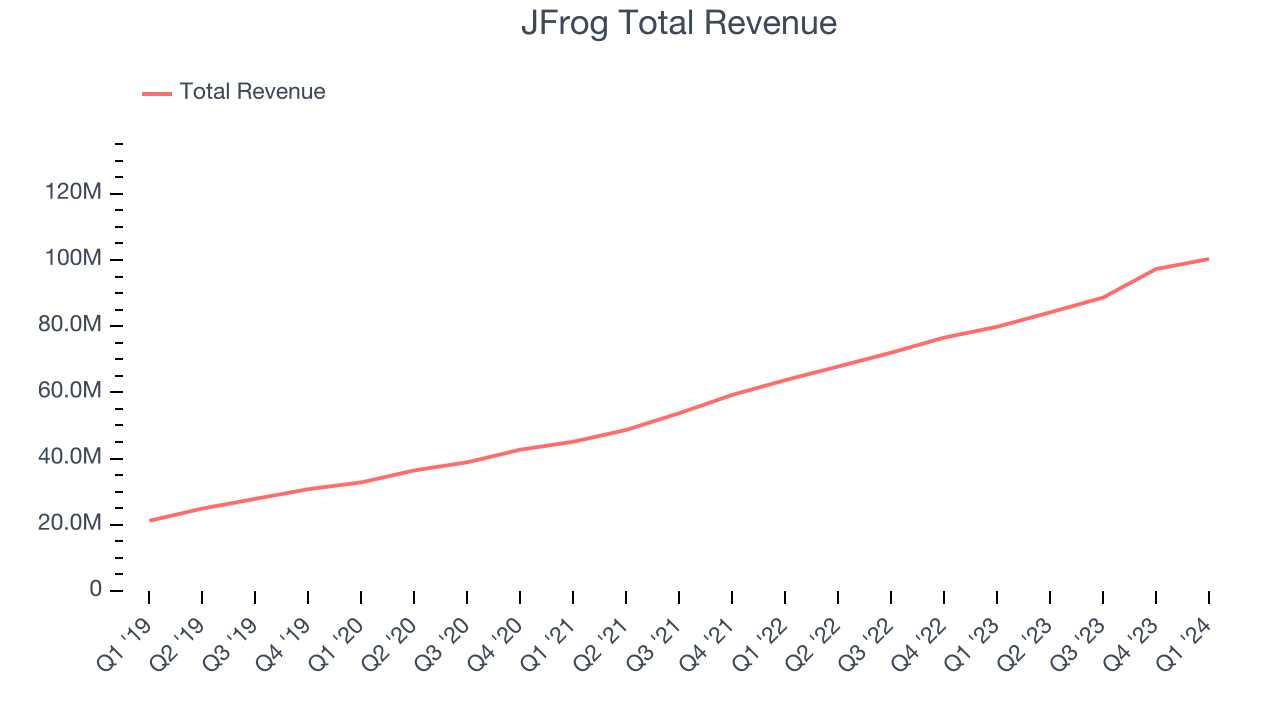
This quarter, JFrog's quarterly revenue was once again up a very solid 25.7% year on year. However, its growth did slow down compared to last quarter as the company's revenue increased by just $3.05 million in Q1 compared to $8.62 million in Q4 CY2023. While we'd like to see revenue increase by a greater amount each quarter, a one-off fluctuation is usually not concerning.
Next quarter's guidance suggests that JFrog is expecting revenue to grow 23% year on year to $103.5 million, in line with the 24.1% year-on-year increase it recorded in the same quarter last year. Looking ahead, analysts covering the company were expecting sales to grow 20.7% over the next 12 months before the earnings results announcement.
Large Customers Growth
This quarter, JFrog reported 911 enterprise customers paying more than $100,000 annually, an increase of 25 from the previous quarter. That's a bit fewer contract wins than last quarter and quite a bit below what we've typically observed over the past four quarters, suggesting that its sales momentum with large customers is slowing.
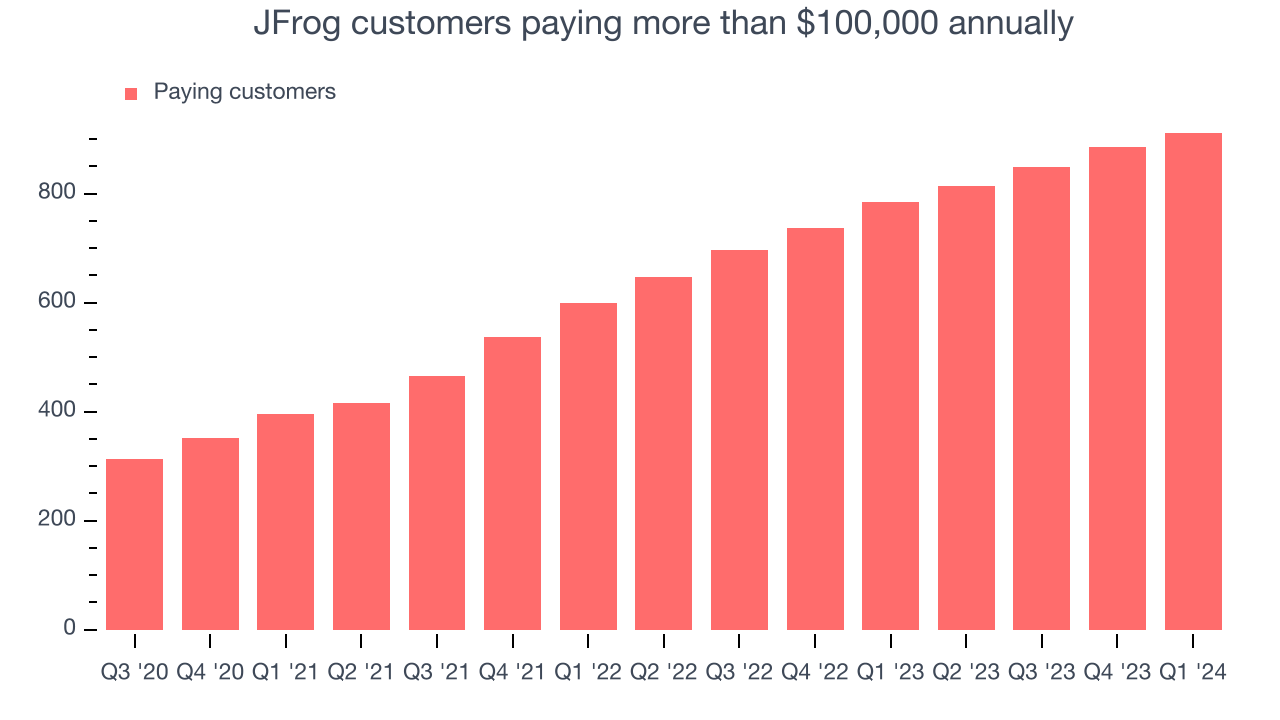
Product Success
One of the best parts about the software-as-a-service business model (and a reason why SaaS companies trade at such high valuation multiples) is that customers typically spend more on a company's products and services over time.
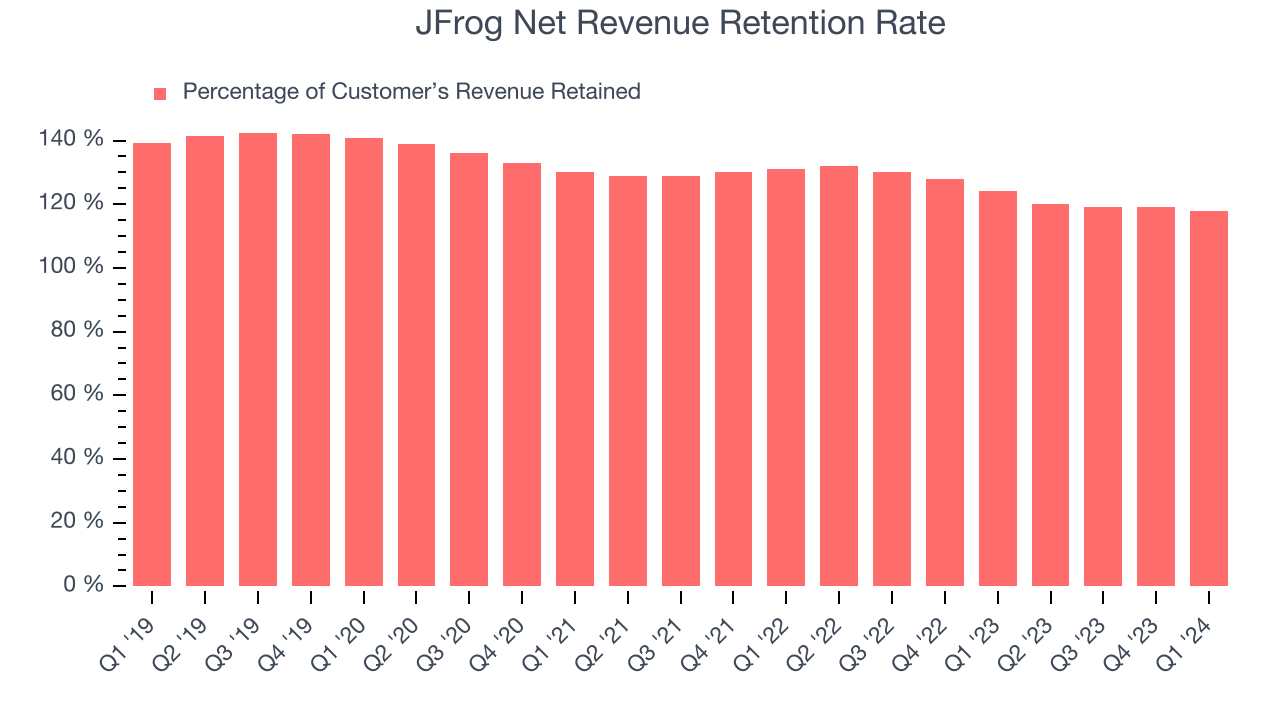
JFrog's net revenue retention rate, a key performance metric measuring how much money existing customers from a year ago are spending today, was 118% in Q1. This means that even if JFrog didn't win any new customers over the last 12 months, it would've grown its revenue by 18%.
Despite falling over the last year, JFrog still has a good net retention rate, proving that customers are satisfied with its software and getting more value from it over time, which is always great to see.
Profitability
What makes the software as a service business so attractive is that once the software is developed, it typically shouldn't cost much to provide it as an ongoing service to customers. JFrog's gross profit margin, an important metric measuring how much money there's left after paying for servers, licenses, technical support, and other necessary running expenses, was 79.5% in Q1.
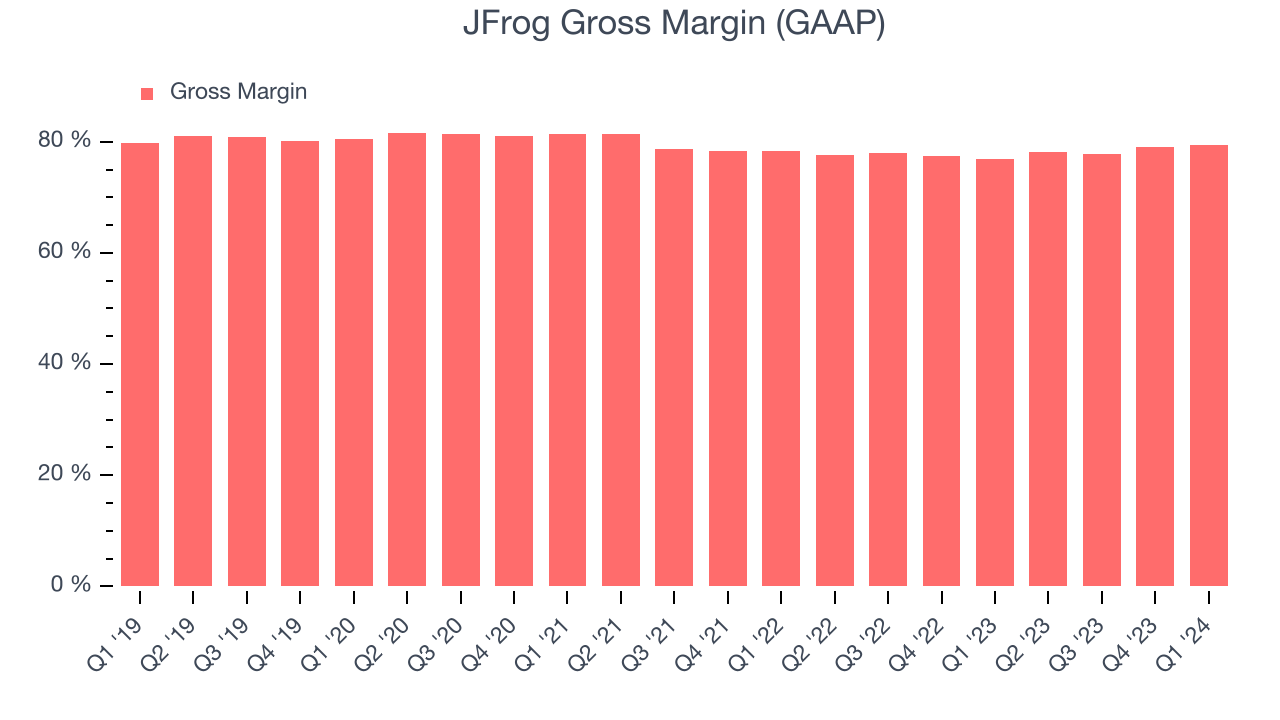
That means that for every $1 in revenue the company had $0.79 left to spend on developing new products, sales and marketing, and general administrative overhead. Trending up over the last year, JFrog's impressive gross margin allows it to fund large investments in product and sales during periods of rapid growth and achieve profitability when reaching maturity.
Cash Is King
If you've followed StockStory for a while, you know that we emphasize free cash flow. Why, you ask? We believe that in the end, cash is king, and you can't use accounting profits to pay the bills. JFrog's free cash flow came in at $16.63 million in Q1, turning positive over the last year.
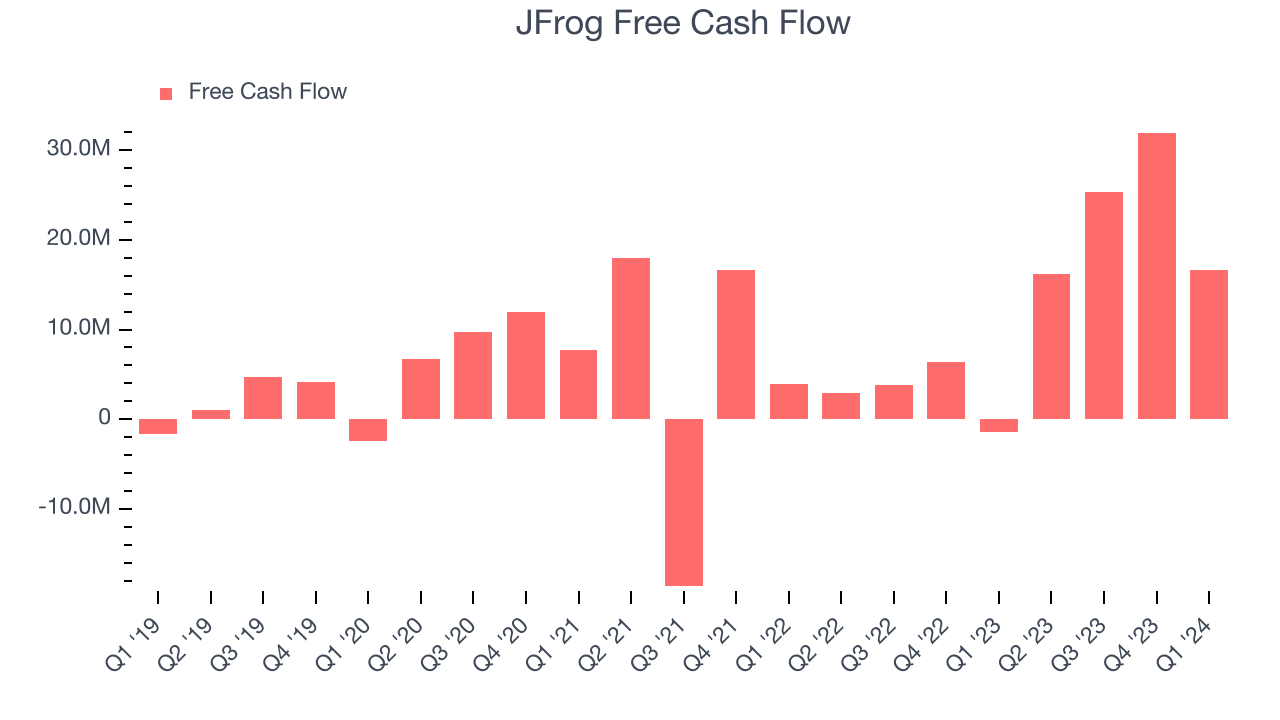
JFrog has generated $90.2 million in free cash flow over the last 12 months, an impressive 24.4% of revenue. This high FCF margin stems from its asset-lite business model and strong competitive positioning, giving it the option to return capital to shareholders or reinvest in its business while maintaining a cash cushion.
Key Takeaways from JFrog's Q1 Results
It was encouraging to see JFrog narrowly top analysts' revenue expectations this quarter. On the other hand, its billings unfortunately missed analysts' expectations and its new large contract wins shrunk. Guidance for next quarter and the full year were roughly in line with expectations. Overall, this was a mixed quarter for JFrog and not as exciting as some of their previous convincing beats. The company is down 10.2% on the results and currently trades at $36.5 per share.
Is Now The Time?
JFrog may have had a mixed quarter, but investors should also consider its valuation and business qualities when assessing the investment opportunity.
There are several reasons why we think JFrog is a great business. While we'd expect growth rates to moderate from here, its revenue growth has been strong over the last three years. Additionally, its customers are increasing their spending quite quickly, suggesting they love the product, and its bountiful generation of free cash flow empowers it to invest in growth initiatives.
The market is certainly expecting long-term growth from JFrog given its price-to-sales ratio based on the next 12 months is 9.7x. But looking at the tech landscape today, JFrog's qualities as one of the best businesses really stand out, and we think that the multiple is justified. We still like the stock at this price.
Wall Street analysts covering the company had a one-year price target of $49.38 right before these results (compared to the current share price of $36.50), implying they see short-term upside potential in JFrog.
To get the best start with StockStory, check out our most recent Stock picks, and then sign up for our earnings alerts by adding companies to your watchlist here. We typically have the quarterly earnings results analyzed within seconds of the data being released. Especially for companies reporting pre-market, this often gives investors the chance to react to the results before everyone else has fully absorbed the information.
